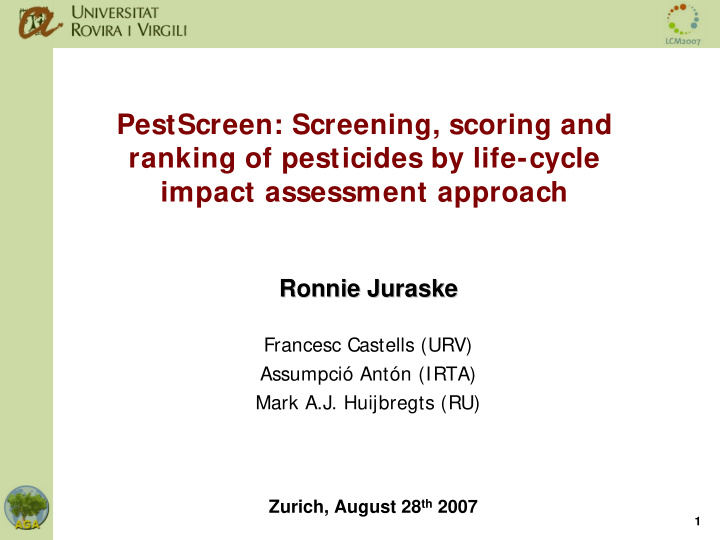



PestScreen: Screening, scoring and ranking of pesticides by life-cycle impact assessment approach Ronnie Juraske Juraske Ronnie Francesc Castells (URV) Assumpció Antón (IRTA) Mark A.J. Huijbregts (RU) Zurich, August 28 th 2007 1
I ntroduction • Pesticide - Any substance or mixture for preventing or destroying any pest • Roughly 2.6 million tonnes of active ingredients ~ $US 38 billion are used annually worldwide • ~ 90% are used in agriculture • Applied to protect crops and maintain high yields → contributing to food supply Introduction . Objectives . Methodology . Results . Conclusions 2
I ntroduction • Pesticides are significant sources of diffuse pollutants that cause health implications upon living organisms including humans • Due to the risk for human toxicity and environmental ecotoxicity pesticides should be under steady observation Introduction . Objectives . Methodology . Results . Conclusions 3
Objectives • Method to calculate the relative risk level of pesticides in order to compare substitute compounds through their ranking. • Implement life-cycle impact assessment methodologies and multi-media model calculations into PestScreen. Introduction . Objectives . Methodology . Results . Conclusions 4
Selection of indicators Dose Fate Exposure Toxicity Degradation half-life BCF fish Ecotox. (aquatic): Application dose LC50 algae Frequency Drift LC50 crutaceans Intake fraction LC50 fish World sales Leaching: Kow Koc Ecotox. (terrestrial): World use Solubility LD50 birds LD50 earthworms LRTP LD50 honey bees Human toxicity: Overall persistence acute: LD50 rat Volitalisation: acute: LD50 mouse Vapour pressure acute: LD50 dog Henry´s law constant chronic: ADI 5 Introduction . Objectives . Methodology . Results . Conclusions
Scoring of indicators For each indicator the complete dataset (217 chemicals) was divided into four quartiles Level of concern Sub-score Pov (days) low 1 ≤ 44 medium 2 44 ≤ 61 high 3 61 < 106 very high 4 ≥ 106 Introduction . Objectives . Methodology . Results . Conclusions 6
PestScore ∑ ∑ ⎛ ⎞ F T E ⎜ ⎟ = = 2 4 = × + = + i 1 i i PestScore D ⎜ ⎟ 2 1 4 ⎝ ⎠ Hazard index Level of concern Class PestScore low I ≤ 2.5 medium II 2.5 ≤ 5.9 high III 5.9 < 12.0 very high IV ≥ 12.0 Introduction . Objectives . Methodology . Results . Conclusions 7
Results Summary of screening results Level of Class Pesticide class concern Herbicides Insecticides Fungicides Rest low I 15 (22%) 20 (28%) 17 (26%) 3 (25%) medium II 8 (11%) 23 (33%) 19 (29%) 4 (33%) high III 22 (32%) 13 (18%) 17 (26%) 3 (25%) very high IV 24 (35%) 15 (21%) 12 (19%) 2 (17%) 69 (100%) 71 (100%) 65 (100%) 12 (100%) Introduction . Objectives . Methodology . Results . Conclusions 8
Results Rank correlation between individual indicators LD50 LD50 LC50 Dose Pov LRTP iF ADI rat bee fish Dose 1.00 Pov 0.02 1.00 LRTP 0.21 0.25 1.00 iF 0.00 0.63 0.34 1.00 ADI 0.00 0.00 0.10 0.10 1.00 LD50 rat 0.00 0.00 0.00 0.20 0.62 1.00 LD50 bee 0.00 0.00 0.00 0.10 0.52 0.67 1.00 LC50 fish 0.00 0.10 0.00 0.10 0.28 0.33 0.38 1.00 Introduction . Objectives . Methodology . Results . Conclusions 9
Results Example1: Fungicides Fenarimol Myclobutanil Triadimenol PestScore: 2.0 PestScore: 1.2 PestScore: 0.6 Introduction . Objectives . Methodology . Results . Conclusions 10
Results Example2: Herbicides Glyphosate Pendimethalin Trifluralin PestScore: 4.5 PestScore: 10.4 PestScore: 12.5 Introduction . Objectives . Methodology . Results . Conclusions 11
Results Example3: Insecticides Buprofezin Pymetrozine Pyriproxyfen PestScore: 5.3 PestScore: 1.4 PestScore: 1.9 Introduction . Objectives . Methodology . Results . Conclusions 12
Conclusions • method may be used for determining the most environmentally friendly active ingredient prior to application • method allows to compare relative risk of pesticides in terms of human and ecosystem health. • May lead to better management and decision- making about pesticide use Introduction . Objectives . Methodology . Results . Conclusions 13
14 Questions?
Recommend
More recommend